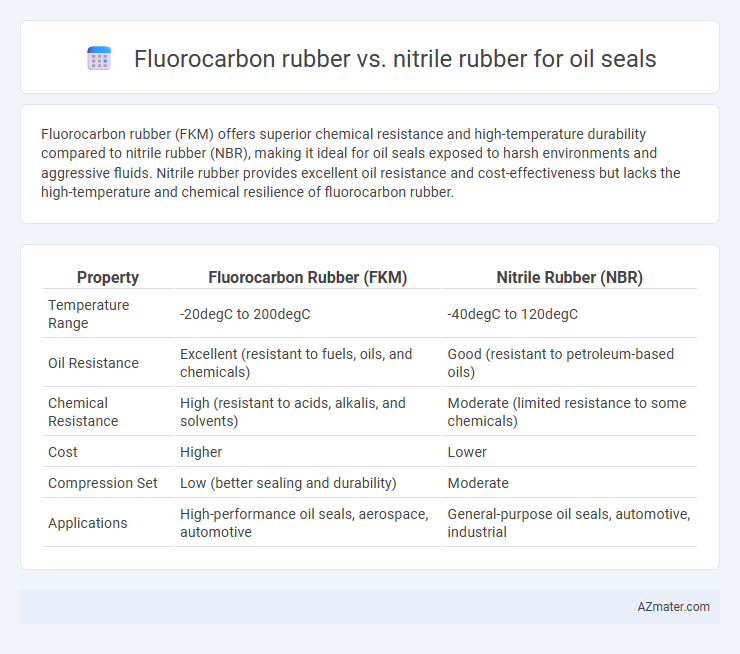Fluorocarbon rubber (FKM) offers superior chemical resistance and high-temperature durability compared to nitrile rubber (NBR), making it ideal for oil seals exposed to harsh environments and aggressive fluids. Nitrile rubber provides excellent oil resistance and cost-effectiveness but lacks the high-temperature and chemical resilience of fluorocarbon rubber.
Table of Comparison
| Property | Fluorocarbon Rubber (FKM) | Nitrile Rubber (NBR) |
|---|---|---|
| Temperature Range | -20degC to 200degC | -40degC to 120degC |
| Oil Resistance | Excellent (resistant to fuels, oils, and chemicals) | Good (resistant to petroleum-based oils) |
| Chemical Resistance | High (resistant to acids, alkalis, and solvents) | Moderate (limited resistance to some chemicals) |
| Cost | Higher | Lower |
| Compression Set | Low (better sealing and durability) | Moderate |
| Applications | High-performance oil seals, aerospace, automotive | General-purpose oil seals, automotive, industrial |
Introduction to Oil Seal Materials
Fluorocarbon rubber (FKM) offers exceptional heat resistance up to 250degC and superior chemical stability, making it ideal for oil seals in harsh environments involving aggressive oils and fuels. Nitrile rubber (NBR) provides excellent resistance to petroleum-based oils and fuels at temperatures up to 120degC, with good mechanical properties and cost-effectiveness for general oil seal applications. Selection between FKM and NBR hinges on operating temperatures, chemical exposure, and cost constraints to ensure optimal oil seal performance and longevity.
Overview of Fluorocarbon Rubber (FKM)
Fluorocarbon rubber (FKM) offers exceptional chemical resistance, high-temperature stability up to 250degC, and superior resistance to oil, fuels, and solvents compared to nitrile rubber (NBR). FKM's molecular structure delivers excellent sealing performance in aggressive environments, making it ideal for oil seals in automotive, aerospace, and industrial applications. Its durability in harsh conditions extends seal life and reduces maintenance costs, outperforming the more affordable but less chemically resistant nitrile rubber options.
Overview of Nitrile Rubber (NBR)
Nitrile Rubber (NBR) is a synthetic elastomer known for its excellent resistance to petroleum oils, fuels, and other chemicals, making it a common choice for oil seals in automotive and industrial applications. Its temperature range typically spans from -40degC to 120degC, offering a balance between cost-efficiency and performance in moderate environments. Compared to Fluorocarbon rubber (FKM), NBR provides superior mechanical strength and abrasion resistance but has lower chemical and heat resistance.
Key Differences: Fluorocarbon vs Nitrile Rubber
Fluorocarbon rubber (FKM) offers superior chemical resistance and high-temperature stability compared to nitrile rubber (NBR), making it ideal for oil seals in harsh environments with exposure to fuels, oils, and solvents. Nitrile rubber provides excellent resistance to petroleum-based oils and good abrasion resistance, but it degrades faster under extreme heat and aggressive chemicals. The choice between fluorocarbon and nitrile rubber depends on application conditions, temperature range, and chemical exposure for optimal oil seal performance.
Chemical Resistance Comparison
Fluorocarbon rubber (FKM) offers superior chemical resistance compared to nitrile rubber (NBR), especially against hydrocarbons, oils, acids, and high-temperature oxidation, making it ideal for demanding oil seal applications in harsh chemical environments. Nitrile rubber excels in resistance to petroleum-based oils and fuels but degrades quickly when exposed to aromatic hydrocarbons, ketones, and certain solvents, limiting its chemical compatibility range. This makes FKM the preferred choice for oil seals requiring enhanced durability and longevity in aggressive chemical and thermal conditions.
Temperature Performance Analysis
Fluorocarbon rubber (FKM) exhibits superior temperature resistance, maintaining stability between -26degC and 204degC, making it ideal for high-temperature oil seal applications. Nitrile rubber (NBR) operates effectively within a narrower range of -40degC to 120degC but offers excellent resistance to petroleum-based oils. The enhanced thermal endurance of fluorocarbon rubber ensures reliable sealing performance and longevity in extreme heat environments compared to nitrile rubber.
Durability and Longevity
Fluorocarbon rubber (FKM) offers superior chemical resistance and can withstand temperatures ranging from -20degC to 200degC, making it highly durable in harsh oil seal applications involving aggressive fuels, oils, and solvents. Nitrile rubber (NBR) operates effectively between -40degC and 120degC with excellent resistance to petroleum-based oils but degrades faster in elevated temperatures and oxidative environments, limiting its longevity. The enhanced thermal stability and chemical inertness of fluorocarbon rubber result in significantly longer service life for oil seals compared to nitrile rubber, especially in demanding industrial conditions.
Cost Comparison
Fluorocarbon rubber (FKM) oil seals typically exhibit higher material and manufacturing costs compared to nitrile rubber (NBR) seals due to superior chemical resistance and temperature tolerance. Nitrile rubber oil seals offer a cost-effective solution with acceptable performance in moderate oil and temperature applications, making them ideal for budget-sensitive projects. However, the initial savings with nitrile may result in higher replacement frequency and maintenance expenses when used in harsher environments.
Application Suitability in Oil Seals
Fluorocarbon rubber (FKM) exhibits superior chemical resistance and high-temperature stability, making it ideal for oil seals in automotive engines, aerospace, and industrial machinery exposed to aggressive oils and fuels. Nitrile rubber (NBR) offers excellent wear resistance and cost-effectiveness, fitting well in applications with moderate temperature ranges and exposure to mineral oils or hydraulic fluids. Selecting between FKM and NBR depends on operating temperature, chemical exposure, and required seal longevity for optimal oil seal performance.
Which Rubber is Best for Your Oil Seal Needs?
Fluorocarbon rubber (FKM) offers superior chemical resistance, high temperature tolerance up to 204degC, and excellent durability, making it ideal for harsh environments with exposure to oils, fuels, and solvents. Nitrile rubber (NBR) provides good oil resistance and tensile strength at a more affordable cost but is limited by lower temperature resistance, typically up to 100degC, which may lead to faster degradation in extreme conditions. Choosing the best rubber depends on your oil seal's operating temperature, chemical exposure, and budget, with FKM preferred for high-performance applications and NBR suitable for standard oil sealing tasks.

Infographic: Fluorocarbon rubber vs Nitrile rubber for Oil seal
 azmater.com
azmater.com